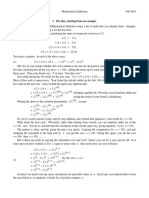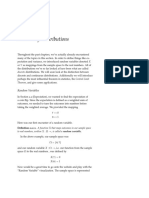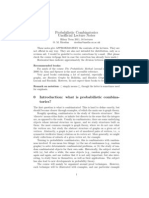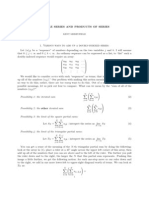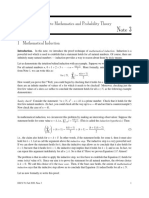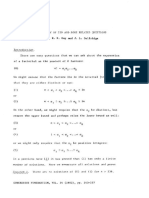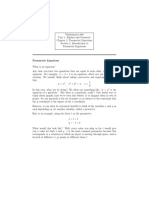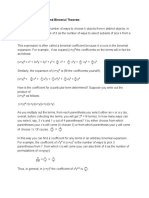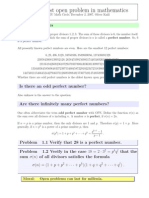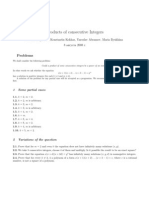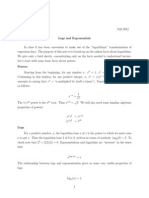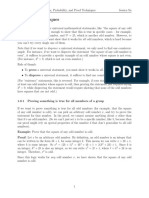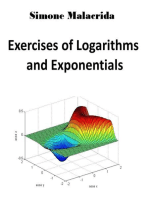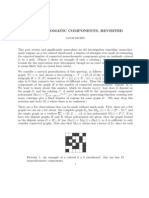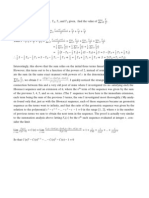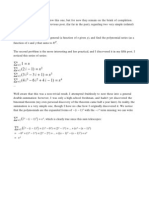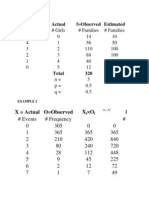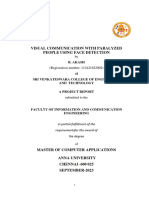Expected Value of The Greatest of A Set of Reals
Expected Value of The Greatest of A Set of Reals
Uploaded by
Jacob RicheyCopyright:
Available Formats
Expected Value of The Greatest of A Set of Reals
Expected Value of The Greatest of A Set of Reals
Uploaded by
Jacob RicheyOriginal Title
Copyright
Available Formats
Share this document
Did you find this document useful?
Is this content inappropriate?
Copyright:
Available Formats
Expected Value of The Greatest of A Set of Reals
Expected Value of The Greatest of A Set of Reals
Uploaded by
Jacob RicheyCopyright:
Available Formats
Using the Finite to Explain the Infinite
I recently considered a seemingly simple problem (that I was surprised I hadnt thought of before):
given k real numbers {x
i
i 0
k
each satisfying x
i
[0, 1], what is the expected value of the largest one
among them?
The exact expected value is given by the expression
]
0
1
]
0
1
]
0
1
Max[x
1
, x
2
, ... x
k
] x
1
x
2
x
k
,
where there are k integrals. Unfortnuately, I was unable to determine a way to evaluate this integral
generally, though not for lack of trying. I still think there may be some recursive method, and more
likely some extremely tedious method for evaluating this integral by splitting it into cases. It can be
evaluated easily for small k: that is, the fact that the integrand is a Max function isnt as weird as it
sounds. Take k 2 as an example:
]
0
1
]
0
1
Max[x, y] x y
]
0
1
_
]
0
y
y x
]
y
1
x x y
]
0
1
| y
2
1
2
1
2
y
2
] y
1
2
|
1
3
y
3
1]
0
1
2
3
Generally, however, we cant do the same thing (splitting the Max function into cases) as easily, since
the other variables are dependent on the integrand, not independent of it.
But enough of the wrong way to go about it. My solution is seemlingly strange, as I began by another
variable, which seems counter-intuitive. Instead of allowing the k numbers to take on any real value
in that range, I allowed them only to take one of n+1 values: in particular, any of the values {0,
1
n
,
2
n
,
,
n1
n
,
n
n
1}, each with equal probability. This way, if we can calculate what the expected value is
given a finite set of possible choices of the k reals, then we can let n , and solve our original
problem.
So, what is the probability that 0 is the largest number in the set? Each of the k numbers would have
to be equal to 0, so this has probability
1
n1
1
n1
1
n1
|
1
n1
]
k
.
What is the probability that
1
n
is the largest number? Each of the k numbers would have to be either
0 or
1
n
, and at least one of them would have to be exactly
1
n
. We may try this: first choose the one that
has value exactly
1
n
, which we can choose k ways each with probability
1
n1
; then the remaining k 1
numbers have 2 different options, giving a total probability of
k
n1
|
2
n1
]
k1
k2
k1
(n1)
k
. But this over-
looks the fact that if one of the remaining k 1 numbers happens to be exactly
1
n
, then the original
number we choose to have that value doesnt have to have that value.
Rather, well go with another counter-intuitive move: add yet another variable! To avoid confusion,
lets call the probability that the largest number is exactly
i
n
P (i). Then we will say that
P(i) _
j 1
k
Q(i, j ), where Q(i, j ) (well refer to it as Q( j ) for short, but it is important to note that it
is a function of i), defined as the probability that the largest value is exactly
i
n
and exactly j of the k
reals are equal to
i
n
. We will now see that calculating Q( j ) is doable without much trouble.
What is Q(1)? We choose the 1 number that is equal to
i
n
, which we can do k ways, then choose the
rest (they have i options, namely the numbers |0,
1
n
,
2
n
, ... ,
i 1
n
|), which gives a total probability of
ki
k1
(1n)
k
.
And what of Q(2)? We choose the 2 numbers equal to
i
n
, which we can do
k
2
ways, then the
remaining ones (each have i options again), giving a total probability of
k
2
i
k2
(1n)
k
.
Seeing a pattern? Generally, we first choose which j numbers are exactly equal to
i
n
, which we can do
k
j
ways, then pick the remaining k j numbers. This gives the value Q( j )
k
j
i
k j
(1n)
k
.
Now we have an explicit value for the expected value: it is
E(k) _
i 0
n
P(i)
i
n
, i.e. the probability of getting that value times the value itself, or
E(k)
1
n(1n)
k
_
i 0
n
_
j 1
k
k
j
i
k j 1
.
We can check quickly that this checks for our k 2 case, letting n :
E(2)
1
n(1n)
2
_
i 0
n
_
j 1
2
2
j
i
2 j 1
1
n(1n)
2
_
i 0
n
(2 i
2
i)
1
n(1n)
2
1
6
n(1 n) (5 4 n)
4 n5
6 n6
,
which quickly becomes
2
3
in the limit.
Generally, this sum is a little tricky to evaluate, but letting n makes it a tad easier.
Lim
n
E(k) Lim
n
1
n(1n)
k
_
i 0
n
_
j 1
k
k
j
i
k j 1
Lim
n
1
n(1n)
k
_
i 0
n
_
k
1
i
k
k
2
i
k1
k
k 1
i
2
k
k
i
Lim
n
1
n(1n)
k
_
i 0
n
k i
k
Lim
n
k
n(1n)
k
_
i 0
n
i
k
First some clarification: between the second and third lines, we removed all the terms but one in the
summigrand (yeah I made it up). How can we do that? Each term would become a polynomial in n of
degree one more than the degree of the i: thats how such sums evaluate (since the binomial coeffi-
cients attached to them are just constants). Thus, as n , only the leading term of the polynomial
will become important (notice that the largest power of i in the summigrand is k, which will become a
polynomial in n of degree k 1, which matches the denominator of the thing multiplying the sum).
But we are still left with the trouble of evaluating that sum: I have done it in general, but there isnt
even an explicit version. I used two different ways of calculating related sums to produce the value of
this sum recursively (the sum Im talking about is _
i 0
n
i
k
, i.e. some polynomial in n thats a function
of k). Heres what I wrote:
Let S
n,x
_
i 1
n
i
x
In general, we write _
i 1
n
((i 1)
p
i
p
) (n 1)
p
1 _
i 1
n
i
p
_
k0
p
_
p
k
i
pk
(1)
k1
(n 1)
p
1 _
k0
p1
p
k
S
n,k
(n 1)
p
1 _
k0
p2
p
k
S
n,k
p S
n, p1
, and finally we have
S
n, p1
1
p
(n 1)
p
1 _
k0
p2
p
k
S
n,k
, or in general,
S
n,x
1
x1
(n 1)
x1
1 _
k0
x1
x 1
k
S
n,k
.
How in the world I came up with this, I will never know. But what I do know is that this actually
helps us to determine what the leading coefficient of the leading term in the expansion of the sum is
(thats all we want, after all, for as n all the lesser terms drop out, and we have
k
1
times that
coefficient as the value for E(k)). The polynomial S
n,x
has a bunch of crap on the right side (that
weird sum): ignore all that stuff, and notice the (n 1)
x1
: that guy has the largest power of n, i.e.
1
x1
n
x1
. This is the coefficient:
1
k1
. Therefore E(k)
k
k1
. Hooray!
A (perhaps) interesting unintended consequence of this is the fact that the sum _
i 0
n
P(i) 1, i.e. that
the probabilities have to sum to 1. This gives us a different series summing to n
k
for any positive
integers n and k:
1
1
(1n)
k
_
i 0
n
_
j 1
k
k
j
i
k j
(1 n)
k
_
i 0
n
_
j 1
k
k
j
i
k j
n
k
_
i 0
n1
_
j 1
k
k
j
i
k j
Oddly enough, this gives one of the two series I mentioned above used to evaluate S
n,x
(as we take
polynomials in n and let k vary). Interestingly, it generalizes a commonly known series: if we let
n 2, we get
2
k
_
i 0
1
_
j 1
k
k
j
i
k j
(1)
k
1
k
2
...
k
k
But then, recursively,
3
k
2
k
2
k1
k
1
2
k2
k
2
... 2
k
k 1
1, or generallly,
(n 1)
k
n
k
n
k1
k
1
... n
k
k 1
1
which is likely provable by some algebraic manipulation; as is so common, our problem-solving
analysis above is the equivalent analysis to that manipulation.
Using the Finite to Explain the Infinite
I recently considered a seemingly simple problem (that I was surprised I hadnt thought of before):
given k real numbers {x
i
i 0
k
each satisfying x
i
[0, 1], what is the expected value of the largest one
among them?
The exact expected value is given by the expression
]
0
1
]
0
1
]
0
1
Max[x
1
, x
2
, ... x
k
] x
1
x
2
x
k
,
where there are k integrals. Unfortnuately, I was unable to determine a way to evaluate this integral
generally, though not for lack of trying. I still think there may be some recursive method, and more
likely some extremely tedious method for evaluating this integral by splitting it into cases. It can be
evaluated easily for small k: that is, the fact that the integrand is a Max function isnt as weird as it
sounds. Take k 2 as an example:
]
0
1
]
0
1
Max[x, y] x y
]
0
1
_
]
0
y
y x
]
y
1
x x y
]
0
1
| y
2
1
2
1
2
y
2
] y
1
2
|
1
3
y
3
1]
0
1
2
3
Generally, however, we cant do the same thing (splitting the Max function into cases) as easily, since
the other variables are dependent on the integrand, not independent of it.
But enough of the wrong way to go about it. My solution is seemlingly strange, as I began by another
variable, which seems counter-intuitive. Instead of allowing the k numbers to take on any real value
in that range, I allowed them only to take one of n+1 values: in particular, any of the values {0,
1
n
,
2
n
,
,
n1
n
,
n
n
1}, each with equal probability. This way, if we can calculate what the expected value is
given a finite set of possible choices of the k reals, then we can let n , and solve our original
problem.
So, what is the probability that 0 is the largest number in the set? Each of the k numbers would have
to be equal to 0, so this has probability
1
n1
1
n1
1
n1
|
1
n1
]
k
.
What is the probability that
1
n
is the largest number? Each of the k numbers would have to be either
0 or
1
n
, and at least one of them would have to be exactly
1
n
. We may try this: first choose the one that
has value exactly
1
n
, which we can choose k ways each with probability
1
n1
; then the remaining k 1
numbers have 2 different options, giving a total probability of
k
n1
|
2
n1
]
k1
k2
k1
(n1)
k
. But this over-
looks the fact that if one of the remaining k 1 numbers happens to be exactly
1
n
, then the original
number we choose to have that value doesnt have to have that value.
Rather, well go with another counter-intuitive move: add yet another variable! To avoid confusion,
lets call the probability that the largest number is exactly
i
n
P (i). Then we will say that
P(i) _
j 1
k
Q(i, j ), where Q(i, j ) (well refer to it as Q( j ) for short, but it is important to note that it
is a function of i), defined as the probability that the largest value is exactly
i
n
and exactly j of the k
reals are equal to
i
n
. We will now see that calculating Q( j ) is doable without much trouble.
What is Q(1)? We choose the 1 number that is equal to
i
n
, which we can do k ways, then choose the
rest (they have i options, namely the numbers |0,
1
n
,
2
n
, ... ,
i 1
n
|), which gives a total probability of
ki
k1
(1n)
k
.
And what of Q(2)? We choose the 2 numbers equal to
i
n
, which we can do
k
2
ways, then the
remaining ones (each have i options again), giving a total probability of
k
2
i
k2
(1n)
k
.
Seeing a pattern? Generally, we first choose which j numbers are exactly equal to
i
n
, which we can do
k
j
ways, then pick the remaining k j numbers. This gives the value Q( j )
k
j
i
k j
(1n)
k
.
Now we have an explicit value for the expected value: it is
E(k) _
i 0
n
P(i)
i
n
, i.e. the probability of getting that value times the value itself, or
E(k)
1
n(1n)
k
_
i 0
n
_
j 1
k
k
j
i
k j 1
.
We can check quickly that this checks for our k 2 case, letting n :
E(2)
1
n(1n)
2
_
i 0
n
_
j 1
2
2
j
i
2 j 1
1
n(1n)
2
_
i 0
n
(2 i
2
i)
1
n(1n)
2
1
6
n(1 n) (5 4 n)
4 n5
6 n6
,
which quickly becomes
2
3
in the limit.
Generally, this sum is a little tricky to evaluate, but letting n makes it a tad easier.
Lim
n
E(k) Lim
n
1
n(1n)
k
_
i 0
n
_
j 1
k
k
j
i
k j 1
Lim
n
1
n(1n)
k
_
i 0
n
_
k
1
i
k
k
2
i
k1
k
k 1
i
2
k
k
i
Lim
n
1
n(1n)
k
_
i 0
n
k i
k
Lim
n
k
n(1n)
k
_
i 0
n
i
k
First some clarification: between the second and third lines, we removed all the terms but one in the
summigrand (yeah I made it up). How can we do that? Each term would become a polynomial in n of
degree one more than the degree of the i: thats how such sums evaluate (since the binomial coeffi-
cients attached to them are just constants). Thus, as n , only the leading term of the polynomial
will become important (notice that the largest power of i in the summigrand is k, which will become a
polynomial in n of degree k 1, which matches the denominator of the thing multiplying the sum).
But we are still left with the trouble of evaluating that sum: I have done it in general, but there isnt
even an explicit version. I used two different ways of calculating related sums to produce the value of
this sum recursively (the sum Im talking about is _
i 0
n
i
k
, i.e. some polynomial in n thats a function
of k). Heres what I wrote:
Let S
n,x
_
i 1
n
i
x
In general, we write _
i 1
n
((i 1)
p
i
p
) (n 1)
p
1 _
i 1
n
i
p
_
k0
p
_
p
k
i
pk
(1)
k1
(n 1)
p
1 _
k0
p1
p
k
S
n,k
(n 1)
p
1 _
k0
p2
p
k
S
n,k
p S
n, p1
, and finally we have
S
n, p1
1
p
(n 1)
p
1 _
k0
p2
p
k
S
n,k
, or in general,
S
n,x
1
x1
(n 1)
x1
1 _
k0
x1
x 1
k
S
n,k
.
How in the world I came up with this, I will never know. But what I do know is that this actually
helps us to determine what the leading coefficient of the leading term in the expansion of the sum is
(thats all we want, after all, for as n all the lesser terms drop out, and we have
k
1
times that
coefficient as the value for E(k)). The polynomial S
n,x
has a bunch of crap on the right side (that
weird sum): ignore all that stuff, and notice the (n 1)
x1
: that guy has the largest power of n, i.e.
1
x1
n
x1
. This is the coefficient:
1
k1
. Therefore E(k)
k
k1
. Hooray!
A (perhaps) interesting unintended consequence of this is the fact that the sum _
i 0
n
P(i) 1, i.e. that
the probabilities have to sum to 1. This gives us a different series summing to n
k
for any positive
integers n and k:
1
1
(1n)
k
_
i 0
n
_
j 1
k
k
j
i
k j
(1 n)
k
_
i 0
n
_
j 1
k
k
j
i
k j
n
k
_
i 0
n1
_
j 1
k
k
j
i
k j
Oddly enough, this gives one of the two series I mentioned above used to evaluate S
n,x
(as we take
polynomials in n and let k vary). Interestingly, it generalizes a commonly known series: if we let
n 2, we get
2
k
_
i 0
1
_
j 1
k
k
j
i
k j
(1)
k
1
k
2
...
k
k
But then, recursively,
3
k
2
k
2
k1
k
1
2
k2
k
2
... 2
k
k 1
1, or generallly,
(n 1)
k
n
k
n
k1
k
1
... n
k
k 1
1
which is likely provable by some algebraic manipulation; as is so common, our problem-solving
analysis above is the equivalent analysis to that manipulation.
2 Expected Value of the Greatest of a Set of Reals.nb
Using the Finite to Explain the Infinite
I recently considered a seemingly simple problem (that I was surprised I hadnt thought of before):
given k real numbers {x
i
i 0
k
each satisfying x
i
[0, 1], what is the expected value of the largest one
among them?
The exact expected value is given by the expression
]
0
1
]
0
1
]
0
1
Max[x
1
, x
2
, ... x
k
] x
1
x
2
x
k
,
where there are k integrals. Unfortnuately, I was unable to determine a way to evaluate this integral
generally, though not for lack of trying. I still think there may be some recursive method, and more
likely some extremely tedious method for evaluating this integral by splitting it into cases. It can be
evaluated easily for small k: that is, the fact that the integrand is a Max function isnt as weird as it
sounds. Take k 2 as an example:
]
0
1
]
0
1
Max[x, y] x y
]
0
1
_
]
0
y
y x
]
y
1
x x y
]
0
1
| y
2
1
2
1
2
y
2
] y
1
2
|
1
3
y
3
1]
0
1
2
3
Generally, however, we cant do the same thing (splitting the Max function into cases) as easily, since
the other variables are dependent on the integrand, not independent of it.
But enough of the wrong way to go about it. My solution is seemlingly strange, as I began by another
variable, which seems counter-intuitive. Instead of allowing the k numbers to take on any real value
in that range, I allowed them only to take one of n+1 values: in particular, any of the values {0,
1
n
,
2
n
,
,
n1
n
,
n
n
1}, each with equal probability. This way, if we can calculate what the expected value is
given a finite set of possible choices of the k reals, then we can let n , and solve our original
problem.
So, what is the probability that 0 is the largest number in the set? Each of the k numbers would have
to be equal to 0, so this has probability
1
n1
1
n1
1
n1
|
1
n1
]
k
.
What is the probability that
1
n
is the largest number? Each of the k numbers would have to be either
0 or
1
n
, and at least one of them would have to be exactly
1
n
. We may try this: first choose the one that
has value exactly
1
n
, which we can choose k ways each with probability
1
n1
; then the remaining k 1
numbers have 2 different options, giving a total probability of
k
n1
|
2
n1
]
k1
k2
k1
(n1)
k
. But this over-
looks the fact that if one of the remaining k 1 numbers happens to be exactly
1
n
, then the original
number we choose to have that value doesnt have to have that value.
Rather, well go with another counter-intuitive move: add yet another variable! To avoid confusion,
lets call the probability that the largest number is exactly
i
n
P (i). Then we will say that
P(i) _
j 1
k
Q(i, j ), where Q(i, j ) (well refer to it as Q( j ) for short, but it is important to note that it
is a function of i), defined as the probability that the largest value is exactly
i
n
and exactly j of the k
reals are equal to
i
n
. We will now see that calculating Q( j ) is doable without much trouble.
What is Q(1)? We choose the 1 number that is equal to
i
n
, which we can do k ways, then choose the
rest (they have i options, namely the numbers |0,
1
n
,
2
n
, ... ,
i 1
n
|), which gives a total probability of
ki
k1
(1n)
k
.
And what of Q(2)? We choose the 2 numbers equal to
i
n
, which we can do
k
2
ways, then the
remaining ones (each have i options again), giving a total probability of
k
2
i
k2
(1n)
k
.
Seeing a pattern? Generally, we first choose which j numbers are exactly equal to
i
n
, which we can do
k
j
ways, then pick the remaining k j numbers. This gives the value Q( j )
k
j
i
k j
(1n)
k
.
Now we have an explicit value for the expected value: it is
E(k) _
i 0
n
P(i)
i
n
, i.e. the probability of getting that value times the value itself, or
E(k)
1
n(1n)
k
_
i 0
n
_
j 1
k
k
j
i
k j 1
.
We can check quickly that this checks for our k 2 case, letting n :
E(2)
1
n(1n)
2
_
i 0
n
_
j 1
2
2
j
i
2 j 1
1
n(1n)
2
_
i 0
n
(2 i
2
i)
1
n(1n)
2
1
6
n(1 n) (5 4 n)
4 n5
6 n6
,
which quickly becomes
2
3
in the limit.
Generally, this sum is a little tricky to evaluate, but letting n makes it a tad easier.
Lim
n
E(k) Lim
n
1
n(1n)
k
_
i 0
n
_
j 1
k
k
j
i
k j 1
Lim
n
1
n(1n)
k
_
i 0
n
_
k
1
i
k
k
2
i
k1
k
k 1
i
2
k
k
i
Lim
n
1
n(1n)
k
_
i 0
n
k i
k
Lim
n
k
n(1n)
k
_
i 0
n
i
k
First some clarification: between the second and third lines, we removed all the terms but one in the
summigrand (yeah I made it up). How can we do that? Each term would become a polynomial in n of
degree one more than the degree of the i: thats how such sums evaluate (since the binomial coeffi-
cients attached to them are just constants). Thus, as n , only the leading term of the polynomial
will become important (notice that the largest power of i in the summigrand is k, which will become a
polynomial in n of degree k 1, which matches the denominator of the thing multiplying the sum).
But we are still left with the trouble of evaluating that sum: I have done it in general, but there isnt
even an explicit version. I used two different ways of calculating related sums to produce the value of
this sum recursively (the sum Im talking about is _
i 0
n
i
k
, i.e. some polynomial in n thats a function
of k). Heres what I wrote:
Let S
n,x
_
i 1
n
i
x
In general, we write _
i 1
n
((i 1)
p
i
p
) (n 1)
p
1 _
i 1
n
i
p
_
k0
p
_
p
k
i
pk
(1)
k1
(n 1)
p
1 _
k0
p1
p
k
S
n,k
(n 1)
p
1 _
k0
p2
p
k
S
n,k
p S
n, p1
, and finally we have
S
n, p1
1
p
(n 1)
p
1 _
k0
p2
p
k
S
n,k
, or in general,
S
n,x
1
x1
(n 1)
x1
1 _
k0
x1
x 1
k
S
n,k
.
How in the world I came up with this, I will never know. But what I do know is that this actually
helps us to determine what the leading coefficient of the leading term in the expansion of the sum is
(thats all we want, after all, for as n all the lesser terms drop out, and we have
k
1
times that
coefficient as the value for E(k)). The polynomial S
n,x
has a bunch of crap on the right side (that
weird sum): ignore all that stuff, and notice the (n 1)
x1
: that guy has the largest power of n, i.e.
1
x1
n
x1
. This is the coefficient:
1
k1
. Therefore E(k)
k
k1
. Hooray!
A (perhaps) interesting unintended consequence of this is the fact that the sum _
i 0
n
P(i) 1, i.e. that
the probabilities have to sum to 1. This gives us a different series summing to n
k
for any positive
integers n and k:
1
1
(1n)
k
_
i 0
n
_
j 1
k
k
j
i
k j
(1 n)
k
_
i 0
n
_
j 1
k
k
j
i
k j
n
k
_
i 0
n1
_
j 1
k
k
j
i
k j
Oddly enough, this gives one of the two series I mentioned above used to evaluate S
n,x
(as we take
polynomials in n and let k vary). Interestingly, it generalizes a commonly known series: if we let
n 2, we get
2
k
_
i 0
1
_
j 1
k
k
j
i
k j
(1)
k
1
k
2
...
k
k
But then, recursively,
3
k
2
k
2
k1
k
1
2
k2
k
2
... 2
k
k 1
1, or generallly,
(n 1)
k
n
k
n
k1
k
1
... n
k
k 1
1
which is likely provable by some algebraic manipulation; as is so common, our problem-solving
analysis above is the equivalent analysis to that manipulation.
Expected Value of the Greatest of a Set of Reals.nb 3
Using the Finite to Explain the Infinite
I recently considered a seemingly simple problem (that I was surprised I hadnt thought of before):
given k real numbers {x
i
i 0
k
each satisfying x
i
[0, 1], what is the expected value of the largest one
among them?
The exact expected value is given by the expression
]
0
1
]
0
1
]
0
1
Max[x
1
, x
2
, ... x
k
] x
1
x
2
x
k
,
where there are k integrals. Unfortnuately, I was unable to determine a way to evaluate this integral
generally, though not for lack of trying. I still think there may be some recursive method, and more
likely some extremely tedious method for evaluating this integral by splitting it into cases. It can be
evaluated easily for small k: that is, the fact that the integrand is a Max function isnt as weird as it
sounds. Take k 2 as an example:
]
0
1
]
0
1
Max[x, y] x y
]
0
1
_
]
0
y
y x
]
y
1
x x y
]
0
1
| y
2
1
2
1
2
y
2
] y
1
2
|
1
3
y
3
1]
0
1
2
3
Generally, however, we cant do the same thing (splitting the Max function into cases) as easily, since
the other variables are dependent on the integrand, not independent of it.
But enough of the wrong way to go about it. My solution is seemlingly strange, as I began by another
variable, which seems counter-intuitive. Instead of allowing the k numbers to take on any real value
in that range, I allowed them only to take one of n+1 values: in particular, any of the values {0,
1
n
,
2
n
,
,
n1
n
,
n
n
1}, each with equal probability. This way, if we can calculate what the expected value is
given a finite set of possible choices of the k reals, then we can let n , and solve our original
problem.
So, what is the probability that 0 is the largest number in the set? Each of the k numbers would have
to be equal to 0, so this has probability
1
n1
1
n1
1
n1
|
1
n1
]
k
.
What is the probability that
1
n
is the largest number? Each of the k numbers would have to be either
0 or
1
n
, and at least one of them would have to be exactly
1
n
. We may try this: first choose the one that
has value exactly
1
n
, which we can choose k ways each with probability
1
n1
; then the remaining k 1
numbers have 2 different options, giving a total probability of
k
n1
|
2
n1
]
k1
k2
k1
(n1)
k
. But this over-
looks the fact that if one of the remaining k 1 numbers happens to be exactly
1
n
, then the original
number we choose to have that value doesnt have to have that value.
Rather, well go with another counter-intuitive move: add yet another variable! To avoid confusion,
lets call the probability that the largest number is exactly
i
n
P (i). Then we will say that
P(i) _
j 1
k
Q(i, j ), where Q(i, j ) (well refer to it as Q( j ) for short, but it is important to note that it
is a function of i), defined as the probability that the largest value is exactly
i
n
and exactly j of the k
reals are equal to
i
n
. We will now see that calculating Q( j ) is doable without much trouble.
What is Q(1)? We choose the 1 number that is equal to
i
n
, which we can do k ways, then choose the
rest (they have i options, namely the numbers |0,
1
n
,
2
n
, ... ,
i 1
n
|), which gives a total probability of
ki
k1
(1n)
k
.
And what of Q(2)? We choose the 2 numbers equal to
i
n
, which we can do
k
2
ways, then the
remaining ones (each have i options again), giving a total probability of
k
2
i
k2
(1n)
k
.
Seeing a pattern? Generally, we first choose which j numbers are exactly equal to
i
n
, which we can do
k
j
ways, then pick the remaining k j numbers. This gives the value Q( j )
k
j
i
k j
(1n)
k
.
Now we have an explicit value for the expected value: it is
E(k) _
i 0
n
P(i)
i
n
, i.e. the probability of getting that value times the value itself, or
E(k)
1
n(1n)
k
_
i 0
n
_
j 1
k
k
j
i
k j 1
.
We can check quickly that this checks for our k 2 case, letting n :
E(2)
1
n(1n)
2
_
i 0
n
_
j 1
2
2
j
i
2 j 1
1
n(1n)
2
_
i 0
n
(2 i
2
i)
1
n(1n)
2
1
6
n(1 n) (5 4 n)
4 n5
6 n6
,
which quickly becomes
2
3
in the limit.
Generally, this sum is a little tricky to evaluate, but letting n makes it a tad easier.
Lim
n
E(k) Lim
n
1
n(1n)
k
_
i 0
n
_
j 1
k
k
j
i
k j 1
Lim
n
1
n(1n)
k
_
i 0
n
_
k
1
i
k
k
2
i
k1
k
k 1
i
2
k
k
i
Lim
n
1
n(1n)
k
_
i 0
n
k i
k
Lim
n
k
n(1n)
k
_
i 0
n
i
k
First some clarification: between the second and third lines, we removed all the terms but one in the
summigrand (yeah I made it up). How can we do that? Each term would become a polynomial in n of
degree one more than the degree of the i: thats how such sums evaluate (since the binomial coeffi-
cients attached to them are just constants). Thus, as n , only the leading term of the polynomial
will become important (notice that the largest power of i in the summigrand is k, which will become a
polynomial in n of degree k 1, which matches the denominator of the thing multiplying the sum).
But we are still left with the trouble of evaluating that sum: I have done it in general, but there isnt
even an explicit version. I used two different ways of calculating related sums to produce the value of
this sum recursively (the sum Im talking about is _
i 0
n
i
k
, i.e. some polynomial in n thats a function
of k). Heres what I wrote:
Let S
n,x
_
i 1
n
i
x
In general, we write _
i 1
n
((i 1)
p
i
p
) (n 1)
p
1 _
i 1
n
i
p
_
k0
p
_
p
k
i
pk
(1)
k1
(n 1)
p
1 _
k0
p1
p
k
S
n,k
(n 1)
p
1 _
k0
p2
p
k
S
n,k
p S
n, p1
, and finally we have
S
n, p1
1
p
(n 1)
p
1 _
k0
p2
p
k
S
n,k
, or in general,
S
n,x
1
x1
(n 1)
x1
1 _
k0
x1
x 1
k
S
n,k
.
How in the world I came up with this, I will never know. But what I do know is that this actually
helps us to determine what the leading coefficient of the leading term in the expansion of the sum is
(thats all we want, after all, for as n all the lesser terms drop out, and we have
k
1
times that
coefficient as the value for E(k)). The polynomial S
n,x
has a bunch of crap on the right side (that
weird sum): ignore all that stuff, and notice the (n 1)
x1
: that guy has the largest power of n, i.e.
1
x1
n
x1
. This is the coefficient:
1
k1
. Therefore E(k)
k
k1
. Hooray!
A (perhaps) interesting unintended consequence of this is the fact that the sum _
i 0
n
P(i) 1, i.e. that
the probabilities have to sum to 1. This gives us a different series summing to n
k
for any positive
integers n and k:
1
1
(1n)
k
_
i 0
n
_
j 1
k
k
j
i
k j
(1 n)
k
_
i 0
n
_
j 1
k
k
j
i
k j
n
k
_
i 0
n1
_
j 1
k
k
j
i
k j
Oddly enough, this gives one of the two series I mentioned above used to evaluate S
n,x
(as we take
polynomials in n and let k vary). Interestingly, it generalizes a commonly known series: if we let
n 2, we get
2
k
_
i 0
1
_
j 1
k
k
j
i
k j
(1)
k
1
k
2
...
k
k
But then, recursively,
3
k
2
k
2
k1
k
1
2
k2
k
2
... 2
k
k 1
1, or generallly,
(n 1)
k
n
k
n
k1
k
1
... n
k
k 1
1
which is likely provable by some algebraic manipulation; as is so common, our problem-solving
analysis above is the equivalent analysis to that manipulation.
4 Expected Value of the Greatest of a Set of Reals.nb
You might also like
- Mathematical Problem SolutionsDocument8 pagesMathematical Problem Solutionsrafael859No ratings yet
- Final ProjectDocument10 pagesFinal ProjectApolos AvrialdoNo ratings yet
- Detailed Analysis of The Binary SearchDocument10 pagesDetailed Analysis of The Binary Searchfor_booksNo ratings yet
- Entire CourseDocument84 pagesEntire CourseJeremyKunNo ratings yet
- Something Around The Number E: Proof: SinceDocument4 pagesSomething Around The Number E: Proof: SinceYul LopeNo ratings yet
- Advanced Problem Solving Lecture Notes and Problem Sets: Peter Hästö Torbjörn Helvik Eugenia MalinnikovaDocument35 pagesAdvanced Problem Solving Lecture Notes and Problem Sets: Peter Hästö Torbjörn Helvik Eugenia Malinnikovaసతీష్ కుమార్No ratings yet
- Maximal Multiplication of All Possible SummandsDocument5 pagesMaximal Multiplication of All Possible SummandsMichael IoshpeNo ratings yet
- Math 25A Section Handout 2 by Gerardo Con DiazDocument5 pagesMath 25A Section Handout 2 by Gerardo Con DiazMariaAntonietaNo ratings yet
- Theorist's Toolkit Lecture 1: Probabilistic ArgumentsDocument7 pagesTheorist's Toolkit Lecture 1: Probabilistic ArgumentsJeremyKunNo ratings yet
- George M. Bergman: 1. The Idea, Starting From An ExampleDocument5 pagesGeorge M. Bergman: 1. The Idea, Starting From An ExampleNgoc Q DuongNo ratings yet
- Probability Handout PART3Document9 pagesProbability Handout PART3Scarlet leeNo ratings yet
- Ch1 Integer PartDocument3 pagesCh1 Integer Partolziich100% (1)
- DS-Lecture 07Document89 pagesDS-Lecture 07moazbinzafar2No ratings yet
- Practice AnsDocument9 pagesPractice AnsEddy R. VélezNo ratings yet
- Probabilistic CombinatoricsDocument42 pagesProbabilistic CombinatoricsFionna SkermanNo ratings yet
- Dynamic Programming:: Example 1: Assembly Line Scheduling. InstanceDocument14 pagesDynamic Programming:: Example 1: Assembly Line Scheduling. Instancekaustubh2008satputeNo ratings yet
- Two Cute ProofsDocument4 pagesTwo Cute ProofsJacob RicheyNo ratings yet
- Beyond Mere ConvergenceDocument9 pagesBeyond Mere ConvergencepablosilvoniNo ratings yet
- Enumerative Combinatorics 1: Subsets, Partitions, PermutationsDocument7 pagesEnumerative Combinatorics 1: Subsets, Partitions, PermutationsAmiraMiraNo ratings yet
- Collatz ConjectureDocument9 pagesCollatz ConjectureTùng Anh LêNo ratings yet
- Double SeriesDocument7 pagesDouble Seriesyacp16761No ratings yet
- Fa22 Bee 068Document21 pagesFa22 Bee 068منیب راجپوتNo ratings yet
- Mathematical Induction in Different Contexts HvitfeldtskaDocument13 pagesMathematical Induction in Different Contexts HvitfeldtskaTamirat GebremariamNo ratings yet
- Sums of Consecutive Integers: Wai Yan Pong California State University, Dominguez Hills February 2, 2008Document7 pagesSums of Consecutive Integers: Wai Yan Pong California State University, Dominguez Hills February 2, 2008paci93No ratings yet
- Berkeley Math Circle - Monthly Contests - Solutions (1999-00)Document4 pagesBerkeley Math Circle - Monthly Contests - Solutions (1999-00)ElevenPlus ParentsNo ratings yet
- Answers Exam 1Document3 pagesAnswers Exam 1Zhastalap AldanyshNo ratings yet
- CS 70 Discrete Mathematics and Probability Theory Spring 2016 Rao and Walrand Note 3 1 Mathematical InductionDocument11 pagesCS 70 Discrete Mathematics and Probability Theory Spring 2016 Rao and Walrand Note 3 1 Mathematical InductionAyesha NayyerNo ratings yet
- Term Paper On Monte Carlo MethodDocument10 pagesTerm Paper On Monte Carlo Methodshreyansh.shuklaNo ratings yet
- Mathematics Logic & Set TheoryDocument57 pagesMathematics Logic & Set Theorynetra14520No ratings yet
- CSE-259 Linear Programming and Analysis of AlgorithmsDocument44 pagesCSE-259 Linear Programming and Analysis of AlgorithmschyonNo ratings yet
- The Abundancy Index of Divisors of Spoof Odd Perfect NumbersDocument17 pagesThe Abundancy Index of Divisors of Spoof Odd Perfect NumbersJose Arnaldo Bebita DrisNo ratings yet
- Permutation and CombinationDocument6 pagesPermutation and Combinationhussainashique995No ratings yet
- 3 InductionDocument11 pages3 InductionzyseecsNo ratings yet
- Powers and rootsDocument11 pagesPowers and rootsMatteo GabrielNo ratings yet
- The Pigeonhole PrincipleDocument9 pagesThe Pigeonhole PrincipleRodolfo Sergio Cruz FuentesNo ratings yet
- Proof of Normal Probability Distribution Function: Ben Cuttriss 22 July 2011Document7 pagesProof of Normal Probability Distribution Function: Ben Cuttriss 22 July 2011Jayakrishnan BhargavanNo ratings yet
- 1 1enDocument8 pages1 1engeric silverioNo ratings yet
- 1982 01erdosDocument15 pages1982 01erdosvahidmesic45No ratings yet
- 1.2.1 Parametric EquationsDocument5 pages1.2.1 Parametric Equationsazakowich25No ratings yet
- Solutions-Manual A Readable Introduction To Real MathDocument61 pagesSolutions-Manual A Readable Introduction To Real Mathrobert5918No ratings yet
- Binomial Coefficients and Binomial TheoremDocument6 pagesBinomial Coefficients and Binomial Theoremsimo simaNo ratings yet
- Chapter 3 PlusDocument12 pagesChapter 3 PlusPavan Kumar P.N.V.S.No ratings yet
- 1 The Binomial SeriesDocument5 pages1 The Binomial SeriesRahul RajNo ratings yet
- Tough ProblemsDocument26 pagesTough ProblemsnihayuNo ratings yet
- Products of Consecutive Integers: ProblemsDocument8 pagesProducts of Consecutive Integers: ProblemsTradelinkdeal UsNo ratings yet
- Korovkin Inequalities LMLDocument74 pagesKorovkin Inequalities LMLht2007xxNo ratings yet
- LogsDocument5 pagesLogsJames TaylorNo ratings yet
- Kenirose A. (NUMBER THEORY)Document4 pagesKenirose A. (NUMBER THEORY)Dock AceNo ratings yet
- Durbin LevinsonDocument7 pagesDurbin LevinsonNguyễn Thành AnNo ratings yet
- CHE 492 HW 3 Fawaz AlsaiedeDocument8 pagesCHE 492 HW 3 Fawaz AlsaiedeTimelessNo ratings yet
- Algorithms - Cody JohnsonDocument22 pagesAlgorithms - Cody JohnsonAndrosNo ratings yet
- CordicDocument8 pagesCordicChinni MshNo ratings yet
- The Binomial Theorem and Combinatorial Proofs: Shagnik DasDocument4 pagesThe Binomial Theorem and Combinatorial Proofs: Shagnik DasAnonymous XSBUbXraNo ratings yet
- Proof TechniquesDocument19 pagesProof TechniquesBut Nobody CameNo ratings yet
- Two Proofs of The Central Limit TheoremDocument13 pagesTwo Proofs of The Central Limit Theoremavi_weberNo ratings yet
- Theorist's Toolkit Lecture 8: High Dimensional Geometry and Geometric Random WalksDocument8 pagesTheorist's Toolkit Lecture 8: High Dimensional Geometry and Geometric Random WalksJeremyKunNo ratings yet
- Lecture2 Semiconductor StatisticsDocument13 pagesLecture2 Semiconductor StatisticsRakib KhanNo ratings yet
- Counting Clusters On A Finite GridDocument18 pagesCounting Clusters On A Finite GridJacob RicheyNo ratings yet
- Bases For The Natural NumbersDocument4 pagesBases For The Natural NumbersJacob RicheyNo ratings yet
- The Iron Bars Problem: Jacob RicheyDocument4 pagesThe Iron Bars Problem: Jacob RicheyJacob RicheyNo ratings yet
- Weight of Natural NumbersDocument6 pagesWeight of Natural NumbersJacob RicheyNo ratings yet
- Monochromatic ComponentsDocument5 pagesMonochromatic ComponentsJacob RicheyNo ratings yet
- Monkeys and BananasDocument2 pagesMonkeys and BananasJacob RicheyNo ratings yet
- Sum ConstructionsDocument6 pagesSum ConstructionsJacob RicheyNo ratings yet
- Needle Experiments Part 1Document4 pagesNeedle Experiments Part 1Jacob RicheyNo ratings yet
- Assorted ProblemsDocument6 pagesAssorted ProblemsJacob RicheyNo ratings yet
- Needles in Haystacks, Oceans and MoreDocument9 pagesNeedles in Haystacks, Oceans and MoreJacob RicheyNo ratings yet
- Magic TricksDocument5 pagesMagic TricksJacob RicheyNo ratings yet
- Mathematics Magazine Problem 1822Document3 pagesMathematics Magazine Problem 1822Jacob RicheyNo ratings yet
- Polynomial SeriesDocument3 pagesPolynomial SeriesJacob RicheyNo ratings yet
- Two Cute ProofsDocument4 pagesTwo Cute ProofsJacob RicheyNo ratings yet
- Cosine ApproximationDocument8 pagesCosine ApproximationJacob RicheyNo ratings yet
- Nested Radical RecursionsDocument4 pagesNested Radical RecursionsJacob RicheyNo ratings yet
- Scheduling ManagementDocument95 pagesScheduling ManagementDrMohamed MustaqNo ratings yet
- 3 1 History of Networks Notes PDFDocument21 pages3 1 History of Networks Notes PDFprodigy1987No ratings yet
- Cyanogen Mod 7.2 para U20a UnlockbootloaderDocument5 pagesCyanogen Mod 7.2 para U20a UnlockbootloaderarcontetetricoNo ratings yet
- Blender UvDocument141 pagesBlender UvMarcos Lins100% (1)
- Enrolment No.: 2017/60189/13351: Aadhaar InformationDocument1 pageEnrolment No.: 2017/60189/13351: Aadhaar InformationPrashantChoudharyNo ratings yet
- Data Integrity in Pharma: Why It Matters and How To Improve ItDocument2 pagesData Integrity in Pharma: Why It Matters and How To Improve ItAli AusatNo ratings yet
- MB MS-7204Document36 pagesMB MS-7204fabilux0% (1)
- Free IDM Serial Keys and Crack (100% Working) - Internet Download Manager Help CenterDocument41 pagesFree IDM Serial Keys and Crack (100% Working) - Internet Download Manager Help Centerlatendra kumar srivastav0% (1)
- CSM 007Document4 pagesCSM 007Khuda BukshNo ratings yet
- Design of FIR FiltersDocument28 pagesDesign of FIR Filtersdivya1587No ratings yet
- FSR ScriptsDocument4 pagesFSR Scriptsapi-26304852No ratings yet
- Initial Thoughts On Quake 3 and Quake 4 SDK Source CodesDocument3 pagesInitial Thoughts On Quake 3 and Quake 4 SDK Source Codesscott_raine_1No ratings yet
- MCA R13 SyllabusDocument121 pagesMCA R13 SyllabusRanjith KumarNo ratings yet
- Practical File ProgramsDocument1 pagePractical File ProgramsEdward KenwayNo ratings yet
- ALPINE MRD-M1000 Car Audio Amplifier SMDocument36 pagesALPINE MRD-M1000 Car Audio Amplifier SMRoger Martínez BermúdezNo ratings yet
- BCA I Year C NotesDocument36 pagesBCA I Year C NotesSandyNo ratings yet
- Curve Fitting1Document20 pagesCurve Fitting1Sneha DwivediNo ratings yet
- Information and Randomness-An Algorithmic PerspectiveDocument487 pagesInformation and Randomness-An Algorithmic Perspectivejltwind0% (1)
- C++ Project On Payroll Management SystemDocument16 pagesC++ Project On Payroll Management Systemraj18021997No ratings yet
- Homework #1Document3 pagesHomework #1Neha ShahNo ratings yet
- Visual Communication With Paralyzed People Using Face DetectionDocument72 pagesVisual Communication With Paralyzed People Using Face Detectionpushpamurugesan19622No ratings yet
- Pan India SVC DetailsDocument8 pagesPan India SVC DetailsAnkush ArethiyaNo ratings yet
- Streamxpert: XML Templates For Tables and Descriptors in Mpeg-2 Private-Section FormatDocument13 pagesStreamxpert: XML Templates For Tables and Descriptors in Mpeg-2 Private-Section Formatparag_ingle123No ratings yet
- Creating Graphs and Charts in ExcelDocument6 pagesCreating Graphs and Charts in Excelapi-228290705No ratings yet
- Lecture 1428550844Document11 pagesLecture 1428550844J Vel MuruganNo ratings yet
- Experiment 10 P, D, I, Pi, PD and Pid Control of A Rotational SystemDocument3 pagesExperiment 10 P, D, I, Pi, PD and Pid Control of A Rotational SystemBhimsen ShresthaNo ratings yet
- Foobar HelpDocument7 pagesFoobar HelpFransiska BudiwatiNo ratings yet
- Activare Office 2013Document4 pagesActivare Office 2013Livius BucurNo ratings yet
- Mth202 Collection of Old PapersDocument35 pagesMth202 Collection of Old Paperscs619finalproject.com100% (1)










